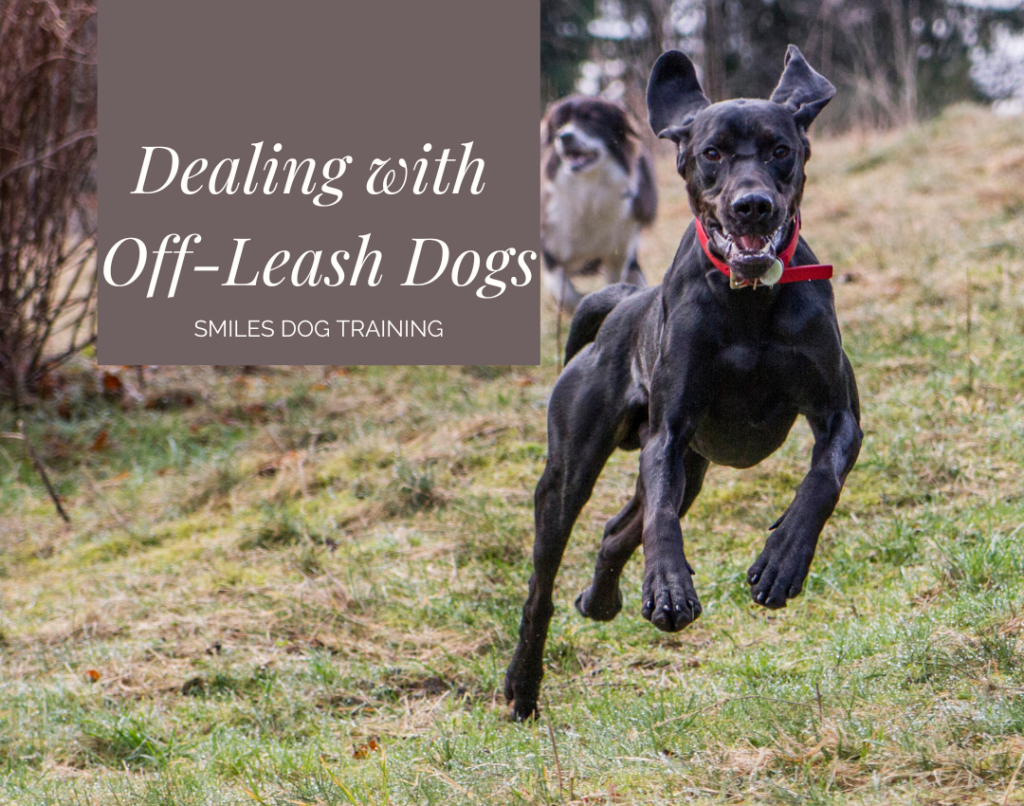Encountering an off-leash dog can be a scary and potentially dangerous situation for both you and your four-legged companion. Whether you’re walking your dog in the park, going for a hike on a trail, doing a sniffari, or just enjoying a casual stroll through your neighborhood, it’s crucial to be prepared for a confrontational encounter. In this blog post, we’ll discuss what to do when faced with an off-leash dog and how you can keep yourself and your dog safe in these situations.
Assessing the Threat
Dogs come in all shapes and sizes, and when encountering an off-leash dog, size can be a significant factor in determining the safety of the interaction.
Smaller dogs are at risk of getting injured during interactions with larger and stronger dogs, even if they were initiated in a playful way. Smaller dogs may also perceive a larger dog to be threatening and escalate the interaction with their own body language and behavior.
Differences in ages should be assessed as well. A healthy adult dog may injure a puppy or senior dog for the same reasons we just mentioned.
If the body language of either dog is showing signs of discomfort or aggression, the potential interaction has a much higher risk of turning into an altercation.
If there are less humans than dogs in an interaction, the risk is higher because it can be very difficult to separate dogs without help.
Best Practices & Strategies
It’s always essential to be cautious and attentive to your surroundings when you are out in a public space.
Make sure your dog is wearing secure walking gear and an ID tag with current contact information in case they get loose during a scuffle. Check out our Shop for some recommendations!
If you see an off-leash dog coming your way, try to stay calm and avoid making eye contact.
If the other dog’s human is present and can see you, wave at them and let them know their dog is making you uncomfortable. Say something like “Please call your pet and put them on leash. We are feeling uncomfortable with the current situation. Thank you for understanding and for taking action.“
Some pet parents are oblivious or callous though and may not agree to what you are asking. If this seems to be the case, move on to the next steps as if the other person isn’t there so you can protect your dog and yourself.
If you have friends or family with you, one person can stay with your dog(s) while the other person heads toward the off-leash dog slowly to increase spatial pressure on it and create an intervention point away from you and your dogs.
What to Do When You Are Alone with an Off-leash Dog Approaching
In my experience, I’ve had success with even something as simple as tossing a handful of treats at the off-leash dog’s face or using hand signals and verbal cues like “stay” or “no” to get a dog to slow down enough while my dog and I got out of there. These can both have a mild startle effect to redirect the dog’s attention.
In addition, stand tall and make yourself look as big as possible while backing away, keeping your attention on the off-leash dog and your dog’s attention on you with a treat distraction or known cues.
Higher Risk Strategies
If the situation is more dire, you may have to escalate to higher risk strategies. I consider all of these higher risk because they have the most potential for injury to yourself or the dogs, as well as escalated excitement or fear from either dog.
For all of the techniques list here, I do recommend that you practice with the item (with and without your dog present) to assess the risk prior to attempting to use it in a high-stress situation.
- If the environment has gravel or other debris, you can kick it toward the off-leash dog as a distraction/deterrent. You can also toss one of your personal items on the ground or toward the off-leash dog as a distraction.
- Carrying an extra leash can be helpful. If the dog continues to approach you can swing it like a helicopter blade between you and the off-leash dog which can be startling for the off-leash dog to see. You can also use it to tether a friendly dog away from your own until you can find that dog’s person.
- Carrying an umbrella is another option. When you see an off-leash dog approaching, you can open the umbrella toward the off-leash dog for a startle effect and to create a visual barrier between you.
- Spray Shield can be a good last resort type of option. It hisses a bit when sprayed so not the greatest option for use around sound-sensitive dogs but it sprays citronella as the deterrent. Spray it toward the dog approaching in a waving motion like you would a bathroom air freshener so the spray can create a stink curtain and you don’t have to have good aim.
- Some professionals recommend carrying pet corrector or an air horn, but I would consider this a very last resort because the risks are highest with these items as these are traditionally aversive deterrents intended to inflict pain/discomfort on anything within range.
Should You Pick Up Your Dog?
Some off-leash dogs may have a negative reaction when you pick up your dog for a variety of reasons.
Dogs communicate through body language, and lifting your dog off the ground can signal to other dogs that there is a problem and it may escalate the situation. It also removes your dog’s ability to communicate discomfort which can lead to friendly dogs continuing their approach with excitement.
Additionally, some dogs have strong predatory behavior sequences, and lifting your dog up may trigger their instincts to chase or attack. Dogs are often reinforced for chasing and attacking toys in our hands during play, and it can be difficult for them to know the difference when you pick up your dog.
Obviously if the threat is high and your gut tells you to pick your dog up, that is a totally reasonable action!
If you do pick up your dog, turn your back to the dog approaching to break the visual contact between them and look for something in your environment to put between you and the off-leash dog. Placing your dog on top of a car or in a trash can temporarily can be a reasonable step to remove the threat until help arrives.
When the Worst Case Scenario Happens
If the dog reaches you and your dog, yell for help and focus on protecting your head, neck, and abdomen from the dog if it attacks you. If the dog attacks your dog, do not grab for collars as you will likely get bit even accidentally by either dog. Instead, focus on restraining the aggressor by using your extra leash as a lasso around their abdomen or grabbing their hips to keep them from chasing if your dog escapes their grip until help arrives and you have an extra set of hands.
After an Incident
If the off-leash dog reaches you and turns out to be friendly, use your extra leash to tether them while you look for their human.
Review our blog post “What to Do if Your Dog Bites Someone”.
Report any incidents of aggressive behavior by off-leash dogs to the appropriate authorities.
If your dog was attacked, even if they seem to be physically fine, take them to the vet for a physical check just to be safe.
Spread awareness about leash laws, the dangers of off-leash dogs, and the incident itself to your friends and neighbors to reduce the chance of this happening to someone else.




